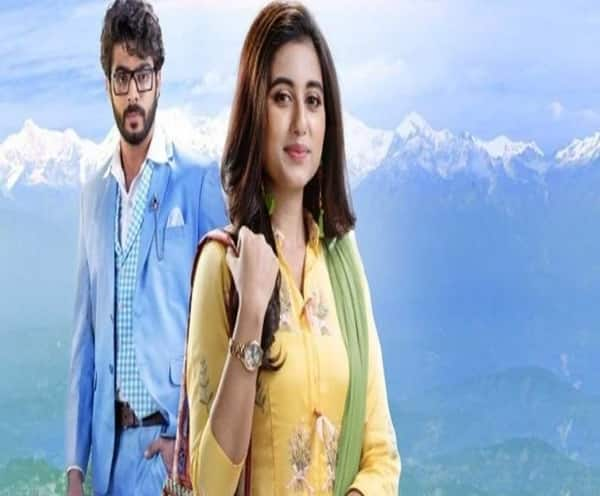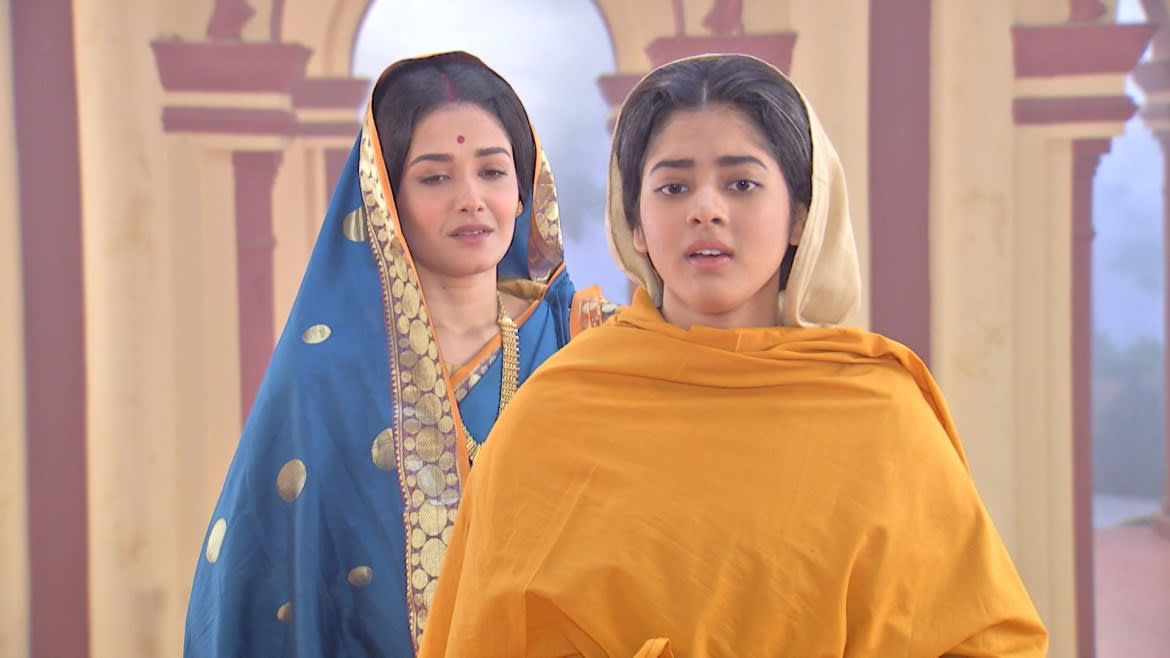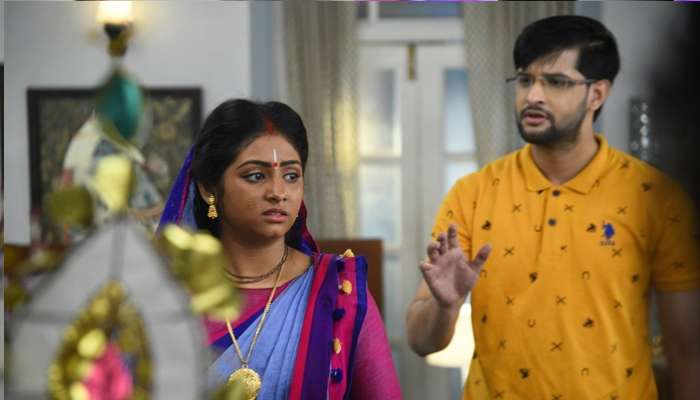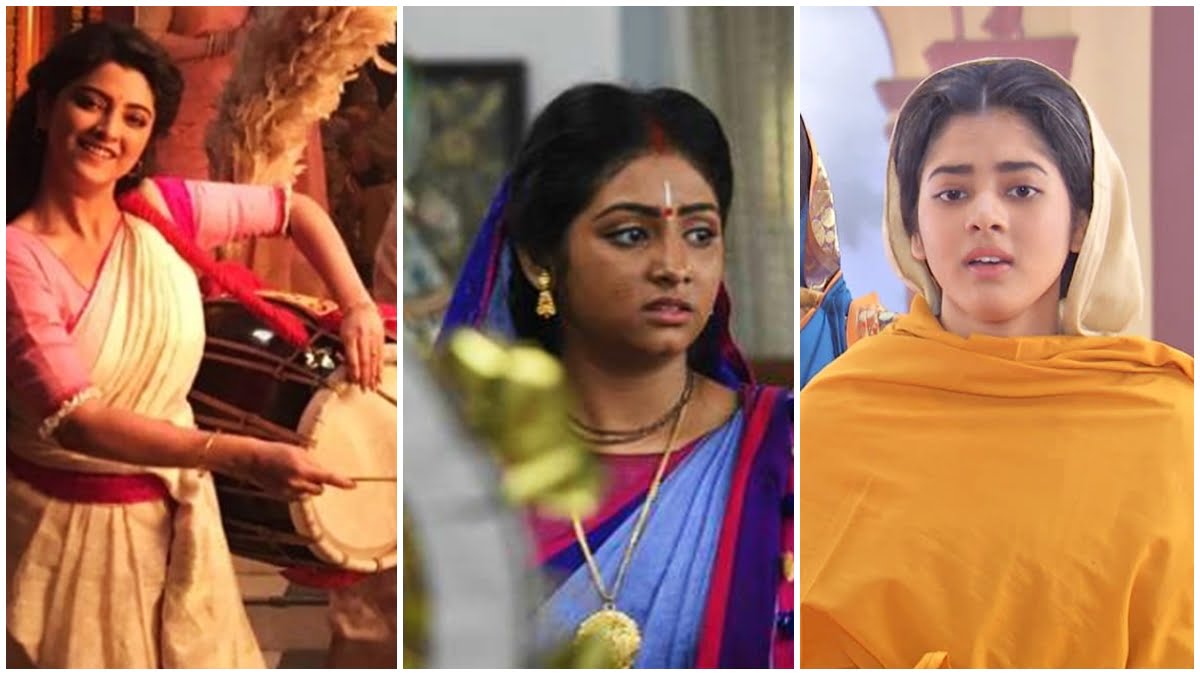In a still from one of the Bengali soap operas on Star Jalsha, called Mohor (currently on air), the namesake protagonist (Sonamoni Saha) is seen leading a students’ protest demanding justice in a case of sexual harassment involving a student who had applied for fees concession owing to her economically marginalised background. The man who has been charged is not only a professor/administrator but the uncle of Mohor’s husband in her just-married joint-family set-up. The said family runs the college administration and thus belongs to the league of men who wield power. As Mohor, the star 3rd year student, is seen protesting, the family is critical of her role. It is seen as antithetical to the image/role of the ghorer bou (daughter-in-law of the house), so much so that the husband is mocked by his family as a weakling who is unable to reign in his wife. While it points to one of Bengal’s hidden chauvinistic gems gliding under a façade of liberal education, the styling stands out. Mohor is not seen wearing bridal jewellery that would have appeared jarring in the face of her protesting stance and within the college premises.
The idiom of the family expecting the daughter-in-law to give up other facets of her identity, image and principles is nothing new though. Marriage for a girl/woman has long been portrayed on Indian television as some sort of a metamorphosis wherein the woman is suddenly expected to appear as an altered being.
For as long as through the two decades of the 21st century, the saga of saas-bahu (daughters-in-law and mothers-in-law) soaps—defined by the Ekta Kapoor brigade of K-serials—have reigned heavily on popular imagination. Glycerine and guilt-bedecked heroines and an army of women characters have meandered through storylines of inter-generational, joint family dramas complemented by tear-jerking twists and turns.
Also read: How Do TV Serials Tackle Representation Of Mental Health Concerns & Stigma
For a large section of the Indian audience, daily soaps still garner massive popularity. So much so that there are Instagram and Facebook fan clubs and platforms like YouTube for say, ABP Ananda’s Hoy Ma Noy Bouma show that track all that go behind the scenes of these Bengali soap operas 24/7.
The heroine’s most formidable quest has been to be everyone’s object of love and affection, which included working tirelessly to entice and catch the fancy of Mr Desirable—the flawed but idealistic suitor/husband. The hero-husband who is either the macho-aggressive Mills and Boons charmer or the mamma’s boy who respects women but idolises his mother to a romantic/chauvinistic fault. At the heart of such serials is the quintessential romance-genre heroine who has to fight all odds and biases pertaining to caste, class, colour and gender.
Even though OTT platforms (55 per cent consumer preference as per a MoMagic 2019 survey) have cannibalised D2H sales, for a large section of the Indian audience daily soaps still garner massive popularity. So much so that there are Instagram and Facebook fan clubs and platforms like YouTube for say, ABP Ananda’s Hoy Ma Noy Bouma show that track all that go behind the scenes of these Bengali soap operas 24/7.

Shaping the Feminine Politics
Catering to a largely female audience, family-oriented Indian television’s daily soaps construct femininity through the good girl-woman and the ideal daughter-sister-wife matrix. While mainstream soap-style femininity is clothed either in plain-Jane garb or bling-ready cocktail fare depending on the context of the character/s, the overall storylines push for the narrative of the girl who has to triumph over evils and yet hold her romantic allure intact.
Stereotypes abound as does tempered sass, over the top style and romantic garnish explaining much of the guilty pleasure associated with daily soap viewing where a husband, son, son-in-law, daughter, daughter-in-law joins in the voyeuristic pleasures of watching another world; a fetishistic world that was or still is perhaps nicely cushioned under urbanity. In her paper, Women and Soap-Operas: Popularity, Portrayal and Perception, Dr Aaliya Ahmed writes, “The term ‘soap opera’ was coined by the American press in the 1930s to denote the extraordinarily popular genre of serialized domestic radio dramas. The ‘soap’ in soap opera alluded to their sponsorship by manufacturers of household cleaning products; while ‘opera’ suggested an ironic incongruity between the domestic narrative concerns of the daytime serial and the most elevated of dramatic forms.”
Dr. Ahmed further writes in this women’s fictional space the female audience identifies and empathises with the women characters and engages with them in a “participatory” role; they see the onscreen characters as projecting their own inner struggles, insecurities and triumphs.
The Durga/Kali Complex and the Mother Figure
In one of the mega Bengali soap operas, Karunamoyee Rani Rashmoni (currently on air), a first among the equals on the great Zee Bangla serial machinery, the titular protagonist Rani Rashmoni (Ditipriya Roy) is the deeply spiritual and liberal-minded “Rani” of 19th-century Bengal. From the young and rebellious Rani to the aged matriarch, Roy owns the entire span of the character, who in real life spearheaded the foundation of some of Kolkata’s iconic addresses such as Dakshineshwar Kali Temple and Babughat. Set in the backdrop of Bengal Renaissance and at the heart of widow remarriage, the show leaps across generations to mirror intergenerational oppression of women hardwired into the social fabric.

Most of Bengali soap operas can be broadly demarcated into biopics and dramas based on historical and literary narratives alongside country-life based content. Though Karunamoyee falls into this bracket, 18-year-old Roy vis-à-vis her character is a household name across the state. While the period drama centred on the mother figure of Rani Rashmoni, herself a devotee of Kali, draws from Bengal’s touring jatra performances, much of its enduring popularity goes to the credit of strong performances of its lead actors.
The heroine in Bengali soap operas is often cast as the ma/mother in keeping with Ma Durga, drawing from prevalent goddess tropes used to describe hyper-feminine/feminist energy in popular Bengali culture, while the Westernised/glamourised and assertive vamp character is cultivated as the hyper-modern anti-heroine.
Also read: What Happened To The Progressive Tamil Serials We Grew Up With?

Welcome to world of warped empowerment: The premise of Zee Bangla’s Jamuna Dhaki, featuring the protagonist Jamuna (Sweta Bhattacharya) who picks up the profession of beating drums—an integral part of Durga puja—is to go against the gendered convention of the profession as women are hardly seen in this role. However, even when this particular stereotype is challenged, the storyline problematises her emancipation by elevating her character to that of a superwoman/goddess. The actor’s looks and get-up in the show has resonances with goddess Durga with her permed hair and potolchera or well drawn-out eyes in place. And, befitting the ten-handed goddess legacy, Jamuna the ideal wife rises to showcase her talents in singing kirtan to cooking delicious sweets, beating the drums and playing the saviour to her disgruntled sister-in-law.

Similarly, Bengali soap operas such as Krishnakali (currently on air) and Trinayani exploit the goddess Kali trope and have dark-skinned protagonists leading the plot. While Krishnakali’s (Tiyasha Roy) character mines her resonances with dark-skinned Krishna and is shown as a Vaishnava/Krishna worshipper proficient in singing bhajans, her dressing draws from the visual culture informing goddess Kali. The skin, the Kali-like hair, the eyes mirroring that of the goddess in Kali idols et al. In fact, Roy’s Krishnakali is anything but the revisionary cult of Kali that challenges standard notions of upper-class beauty and Brahminical notions of caste purity. The protagonist is brown-faced in the show committing a crime of racist overtone. Similarly, Trinayani (Sruti Das) or one with the third eye, with a veiled reference to the goddess is shown to possess skills of predicting the future with her blessed vision. Such associations of dark-skinned leads with misinformed goddess cults, magic etc further reinforce existing stereotypes.
The Bengali Bhadramohila and the Sweet Shompurna
Broadly speaking, the portrayal of women in Bengali soap operas traverses the tropes of the Bengali bhodromohila—the lady-like counterpart to the quintessential Bengali bhodrolok known for his readings, intellectual taste and good manners.

Perhaps a show that stands apart from other Bengali soap operas as holistic, the lead protagonist Parameshwari (Koneenica Banerjee) in Zee Bangla’s Andarmahal, holds her weight through her unequivocal support for justice and eventually builds a successful career in music.
Perhaps a show that stands apart from other Bengali soap operas as holistic, the lead protagonist Parameshwari (Koneenica Banerjee) in Zee Bangla’s Andarmahal, holds her weight through her unequivocal support for justice and eventually builds a successful career in music. She epitomises the Bengali bhodromohila and yet challenges it through her argumentative spirit. A nurturer to her step-daughter in her rich marital household, she challenges the authority of her father-in-law and teaches him a lesson in respecting his own wife and rising above his class- based prejudices. Clad in semi-working woman saris, Parameshwari cultivates her musical talent and weaponises it to be empowered. Though she embraces motherhood as an important aspect of her being, she doesn’t limit herself to it thereby rising above the arcs of everyday misogyny within the andarmahal or the inner quarters.
The Argumentative Activist and the Career Caricaturist
National award-winning actor Indrani Halder plays Sreemoyee (Star Jalsha, on air) in the namesake show; a wronged wife, whose husband cheats her for another woman. The strong-willed Sreemoyee picks up her self-esteem and makes everyone value her opinions. Transcending the graph of her personal empowerment, she picks up causes of women empowerment in the form of social work. Dressed in middle-class Bengali saris worn with plain, black blouses, big, black bindi—often associated with women activists in Bengal—centrally parted, plaited hair, wrist watch and handbag, Sreemoyee’s character exudes resonances with middle-class domesticity that is not designed on excess. In Zee Bangla’s Goyenda Ginni, Halder’s home-grown detective character is a mellower version as she straddles both parts of a dutiful homemaker and a spirited detective; a sweet shompurna, the Bengali word for a complete woman.
Sampriti Poddar’s Phirki, in Zee Bangla’s namesake serial like Mohor is another younger protagonist on screen. Phirki is the foster daughter of the trans person Lokkhi (Arja Banerjee) who studies to be a lawyer but is caught as a daughter-in-law in a political family. Even though Phirki raises pertinent points questioning societal dogma and inherent sexism, she performs femininity vis-à-vis her romantic relationship; it’s akin to code-switching between the so called feminist and feminine. Since much of television is visual in meaning and messaging, Phirki’s transformation from wearing wash-and-wear saris with a simple handbag and wristwatch to brocade weaves and heavy gold necklaces tell much. Alia, the vamp, flaunts curled, bronzed locks, gowns and luxury handbags.
However, the most disheartening facet of the show lies in the gifted actor, Arja Banerjee, playing Lokkhi a trans woman, whereas an artist from the transgender community could have raised the bar of an already skewered representational ratio.
Swastika Dutta’s Radhika of Ki Kore Bolbo Tomay, on the other hand, gets a lesson in reading scriptures from the family’s matriarch, her husband’s grandmother. In a bewildering feat, Radhika the fashion designer’s career is acknowledged and held morally correct as it serves as a support to her husband’s career as the reigning boss of his family garments business. That her career is caricatured is jarring for the otherwise smart and stylish Radhika who is able to channel her own aspirations.
Even though this space remains important for articulating stories of the subaltern and suburbs, these contemporary romance-genre heroines in Bengali soap operas haven’t travelled much in terms of the realisation of their individual selves.
There’s no pursuit of pleasure in their character graphs; as if pleasure is unfeminine and anti-feminist, as if the only path to emancipation is through the social-reform route. The ideal wife and the benign mother image prevail in bengali soaps; we will still have to wait for the woke heroine who loves/unloves on her own terms without any tinge of pathos and the career woman who values her work for her own sake.
About the author(s)
Sanhati Banerjee is a Kolkata-based independent journalist with special interests in literature, culture and gender.




